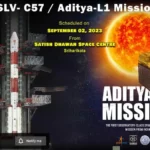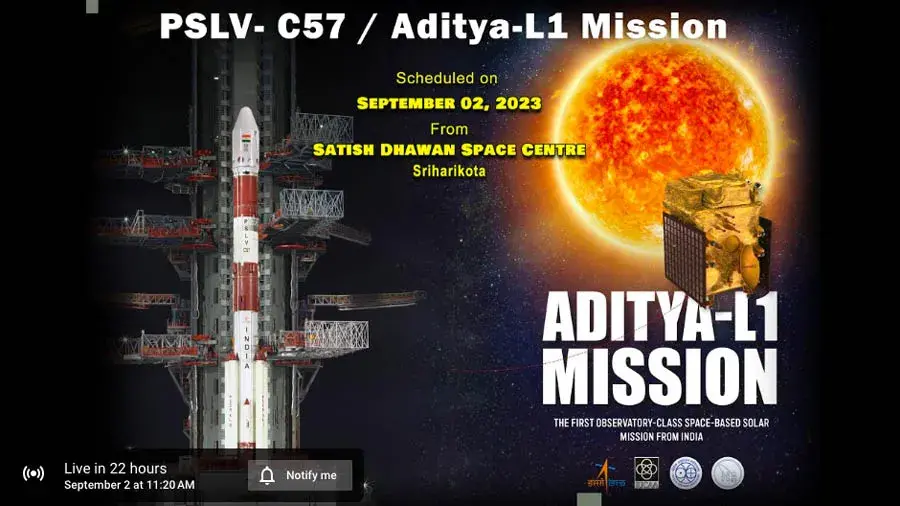ArdorComm News Network
September 2, 2023
In a historic leap for India’s space exploration endeavours, the Indian Space Research Organisation (ISRO) has achieved a remarkable milestone with the successful launch of the Aditya-L1 solar observatory. This mission marks India’s inaugural foray into dedicated solar research, as the spacecraft embarks on a groundbreaking journey to the Sun-Earth L1 point. With precise placement into its intended orbit, Aditya-L1 now sets its sights on unravelling the enigmas of our nearest star, promising groundbreaking insights into solar dynamics and their influence on space weather. This mission not only positions ISRO at the forefront of solar science but also holds immense potential for advancing our understanding of the solar system’s intricate workings and their implications for life on Earth.
PSLV-C57/Aditya-L1 Mission:
The launch of Aditya-L1 by PSLV-C57 is accomplished successfully.
The vehicle has placed the satellite precisely into its intended orbit.
India’s first solar observatory has begun its journey to the destination of Sun-Earth L1 point.
— ISRO (@isro) September 2, 2023
Prime Minister Narendra Modi congratulated the scientists and engineers at ISRO for the successful launch of India’s first Solar Mission, Aditya -L1.
After the success of Chandrayaan-3, India continues its space journey.
Congratulations to our scientists and engineers at @isro for the successful launch of India’s first Solar Mission, Aditya -L1.
Our tireless scientific efforts will continue in order to develop better…
— Narendra Modi (@narendramodi) September 2, 2023
Aditya-L1 will be India’s pioneering space-based mission focused on unravelling the mysteries of our nearest star, the Sun. This state-of-the-art spacecraft will be positioned in a halo orbit around the Lagrange point 1 (L1) of the Sun-Earth system, situated approximately 1.5 million kilometers from Earth. This unique orbit offers a significant advantage – uninterrupted views of the Sun, free from any eclipses or occultations. Consequently, Aditya-L1 will provide invaluable real-time observations of solar activities and their impact on space weather.
The spacecraft is equipped with seven payloads designed to observe various layers of the Sun, including the photosphere, chromosphere, and the outermost layer, the corona. These payloads utilize electromagnetic, particle, and magnetic field detectors to gather data. Positioned at the Lagrange point L1, four of these payloads will directly observe the Sun, while the remaining three will conduct in-situ studies of particles and fields, offering crucial insights into the dynamics of solar activity within the interplanetary medium.
The Aditya-L1 payloads are expected to deliver vital information on several key aspects, including the enigmatic problem of coronal heating, coronal mass ejections, pre-flare and flare activities, space weather dynamics, and the propagation of particles and fields in space.
Science Objectives: The primary scientific objectives of the Aditya-L1 mission encompass:
- Solar Atmospheric Dynamics: Investigating the dynamics of the solar upper atmosphere, particularly the chromosphere and corona.
- Coronal Heating and Plasma Physics: Studying the mechanisms behind chromospheric and coronal heating, as well as the behavior of partially ionized plasma, initiation of coronal mass ejections, and solar flares.
- Particle Dynamics: Observing the in-situ particle and plasma environment to provide data for understanding particle dynamics originating from the Sun.
- Corona Heating Mechanism: Examining the physics of the solar corona and its heating mechanisms.
- Plasma Diagnostics: Providing diagnostics for coronal and coronal loop plasma, including temperature, velocity, and density measurements.
- Coronal Mass Ejections: Investigating the development, dynamics, and origins of coronal mass ejections (CMEs).
- Magnetic Field Studies: Studying magnetic field topology and measurements in the solar corona.
- Space Weather Drivers: Identifying the drivers for space weather, including the origin, composition, and dynamics of the solar wind.
The launch of Aditya-L1 heralds a significant milestone in India’s space research efforts, positioning the country at the forefront of solar science and space weather forecasting. As Aditya-L1 embarks on its mission to unlock the secrets of the Sun, it promises to shed light on crucial aspects of our solar system, benefiting both scientific understanding and practical applications on Earth.


